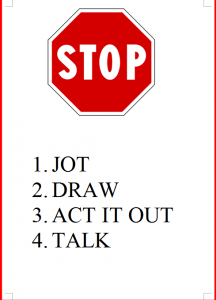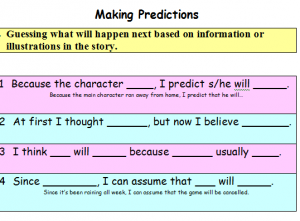Speaking is a vehicle by which learning happens. Students acquire language by first listening, then speaking, reading and last writing. When you are teaching a concept and think your students understand —ask them to explain it. How often do the ideas of the students become tangled and off topic? When a child cannot clearly articulate the ideas you have taught—they do not fully understand or comprehend.
Simply having students talking through their ideas will increase learning and retention of the information. Notice these statistics on retention of information:
|
Teaching Strategy Applied |
Percent of Material Retained |
Examples in the Classroom |
|
Students share and re-teach someone else what they have learned
|
90% |
Reciprocal teaching and sharing of ideas by students |
|
Student Practice What they Have Learned |
75% |
Centers, students applying strategies while reading or math in small groups or independently This often includes creating or producing a product
|
|
Group Discussion
|
50% |
Group discussion on a topic where teacher uses questioning and students share their ideas on the topic as well as the teacher provides corrective feedback when needed
|
|
Listening to a lecture with visuals and a demonstration |
30% |
Direct Teaching with a PPT/Prezi or Flipchart In addition teacher shows a video clip, demonstrates a concept or draws a picture to help students understand
|
|
Listening to a lecture with visuals |
20% |
Direct Teaching with a PPT/Prezi or Flipchart
|
|
Reading Material |
10%
|
Reading an article and answering questions
|
|
Lecture |
5%
|
Direct Teaching of Material (Teacher Talking) |
(Statistics accessed from: http://www.psychotactics.com/art-retain-learning/)
How can we ensure our students are maximizing learning?
Visuals and video clips add to learning but collaboration and sharing ideas elevates learning. By combining listening, speaking, reading and writing into lessons; you are ensuring that students are actively engaged into the lesson. Sharing material increases the probability the information will be coded into memory by making neural connections.
Here are three easy activities that you can incorporate into your lessons daily to encourage discussion and increase learning.
#1 Turn and Talk: Simple I know! Have students grouped so that everyone has a partner. There are many configurations such as shoulder partners or face partners but any designated person will work. By designating the partners ahead of time you will have less downtime. After you have taught a “chunk of information” say turn and talk. Have students turn to their partner and paraphrase what they are learning. After one person shares, the next person responds and shares their version.
#2 FRIEZE which is a fancy way of saying a “statue or decoration” created by your students. After you have taught information, a vocabulary word or concept, have students meet with a pre-designated group of 3-4 students. Students are charged with creating a still “statue or scene” that depicts the concept they have learned. The teacher than should take a picture with a device. Students work together to caption the photo and synthesize the information in written form to further deepen their learning.
#3 Sketch it and Talk it Out: After teaching a concept, students should sketch a visual. You should give no directions other than “sketch it.” Students will have to process the information that they know and put it into their own thoughts. Next, the teacher should pair students after 3 minutes to share their sketch and explain their thoughts. To take it a step further you can have students caption the sketch for their partner and then defend their caption choice which takes it to the top of Bloom’s Taxonomy Framework.
These are simple activities that encourage students to think about what they are learning, synthesize that information and apply it by sharing it with someone else. Students learning how to paraphrase and defend their thinking encourages retention of information. In October, I wrote a blog post about Read Aloud and shared a poster. I used to keep this up in the classroom with the following words: STOP Draw, STOP Act Out, Stop Jot, and Stop and Talk. These are the options students would participate in as we read and made notes in their reading journals. This requires little to no prep except to have predetermined groupings or pairings for your students. Remember pairing learning with visuals increases retention forty two percent.
Wiggling students and springtime sunshine go together. Try out one or more of these strategies and see if you don’t get positive results. When students are in engaged in their learning and processing their own information instead of regurgitating back information positive results occur.


